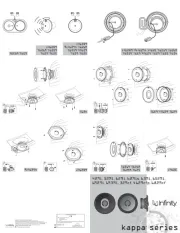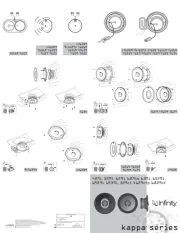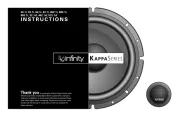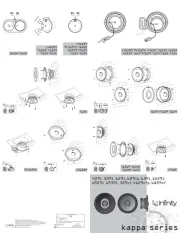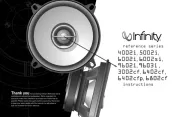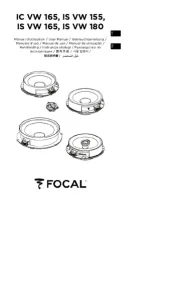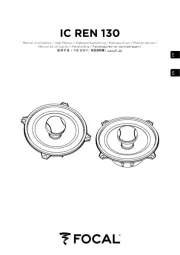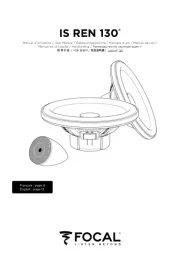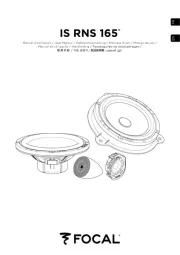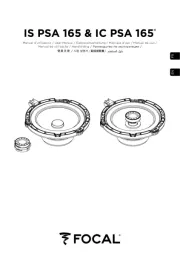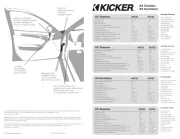
Declaration of Conformity
We, Harman International, Consumer Division
declare in own responsibility that the products described in this owner’s
manual are in compliance with technical standards:
Harman Consumer Group, Inc.
Château du Loir, France 1/09
DCR (ohms) 2.30 2.30 2.30
Mms (g) 12.98 12.98 12.69
Sd (sq cm) 132.7 132.7 132.7
6032i 6032cf 6032si 6032gr
Type: 6-1/2” (160mm) 6-1/2” (160mm) 6-1/2” (160mm) GRILLE ONLY
2-Way 2-Way Shallow-Mount for 6-1/2” (160mm)
Impedance: 2 Ohms 2 Ohms 2 Ohms
Power Handling, RMS: 60W 60W 50W
Power Handling, Peak: 180W 180W 150W
Frequency Response: 53Hz – 21kHz 53Hz – 21kHz 53Hz – 21kHz
Sensitivity (2.83V, 1m): 93dB 93dB 93dB
Grilles are included with the “i” version; they are optional for the “cf” and “si” versions
(use Reference model 6032gr).
Reference Series speakers are warranted against defects.
The duration of the speaker’s warranty depends on the laws in the country in which it
was purchased. Your local Infinity car audio retailer can help you determine the length
of your warranty. To register your product, please visit us at www.infinitysystems.com.
6032i 6032cf 6032si 6032gr
Type: 6-1/2” (160mm) 6-1/2” (160mm) 6-1/2” (160mm) GRILLE ONLY
2-Way 2-Way Shallow-Mount for 6-1/2” (160mm)
Impedance: 2 Ohms 2 Ohms 2 Ohms
Power Handling, RMS: 60W 60W 50W
Power Handling, Peak: 180W 180W 150W
Frequency Response: 53Hz – 21kHz 53Hz – 21kHz 53Hz – 21kHz
Sensitivity (2.83V, 1m): 93dB 93dB 93dB
Grilles are included with the “i” version; they are optional for the “cf” and “si” versions
(use Reference model 6032gr).
Reference Series speakers are warranted against defects.
The duration of the speaker’s warranty depends on the laws in the country in which it
was purchased. Your local Infinity car audio retailer can help you determine the length
of your warranty. To register your product, please visit us at www.infinitysystems.com.
6032i 6032cf 6032si 6032gr
Type: 6-1/2” (160mm) 6-1/2” (160mm) 6-1/2” (160mm) GRILLE ONLY
2-Way 2-Way Shallow-Mount for 6-1/2” (160mm)
Impedance: 2 Ohms 2 Ohms 2 Ohms
Power Handling, RMS: 60W 60W 50W
Power Handling, Peak: 180W 180W 150W
Frequency Response: 53Hz – 21kHz 53Hz – 21kHz 53Hz – 21kHz
Sensitivity (2.83V, 1m): 93dB 93dB 93dB
Grilles are included with the “i” version; they are optional for the “cf” and “si” versions
(use Reference model 6032gr).
Reference Series speakers are warranted against defects.
The duration of the speaker’s warranty depends on the laws in the country in which it
was purchased. Your local Infinity car audio retailer can help you determine the length
of your warranty. To register your product, please visit us at www.infinitysystems.com.
6032i 6032cf 6032si 6032gr
Type: 6-1/2” (160mm) 6-1/2” (160mm) 6-1/2” (160mm) GRILLE ONLY
2-Way 2-Way Shallow-Mount for 6-1/2” (160mm)
Impedance: 2 Ohms 2 Ohms 2 Ohms
Power Handling, RMS: 60W 60W 50W
Power Handling, Peak: 180W 180W 150W
Frequency Response: 53Hz – 21kHz 53Hz – 21kHz 53Hz – 21kHz
Sensitivity (2.83V, 1m): 93dB 93dB 93dB
Grilles are included with the “i” version; they are optional for the “cf” and “si” versions
(use Reference model 6032gr).
Reference Series speakers are warranted against defects.
The duration of the speaker’s warranty depends on the laws in the country in which it
was purchased. Your local Infinity car audio retailer can help you determine the length
of your warranty. To register your product, please visit us at www.infinitysystems.com.
6032i 6032cf 6032si 6032gr
Type: 6-1/2” (160mm) 6-1/2” (160mm) 6-1/2” (160mm) GRILLE ONLY
2-Way 2-Way Shallow-Mount for 6-1/2” (160mm)
Impedance: 2 Ohms 2 Ohms 2 Ohms
Power Handling, RMS: 60W 60W 50W
Power Handling, Peak: 180W 180W 150W
Frequency Response: 53Hz – 21kHz 53Hz – 21kHz 53Hz – 21kHz
Sensitivity (2.83V, 1m): 93dB 93dB 93dB
Grilles are included with the “i” version; they are optional for the “cf” and “si” versions
(use Reference model 6032gr).
Reference Series speakers are warranted against defects.
The duration of the speaker’s warranty depends on the laws in the country in which it
was purchased. Your local Infinity car audio retailer can help you determine the length
of your warranty. To register your product, please visit us at www.infinitysystems.com.
6032i 6032cf 6032si 6032gr
Type: 6-1/2” (160mm) 6-1/2” (160mm) 6-1/2” (160mm) GRILLE ONLY
2-Way 2-Way Shallow-Mount for 6-1/2” (160mm)
Impedance: 2 Ohms 2 Ohms 2 Ohms
Power Handling, RMS: 60W 60W 50W
Power Handling, Peak: 180W 180W 150W
Frequency Response: 53Hz – 21kHz 53Hz – 21kHz 53Hz – 21kHz
Sensitivity (2.83V, 1m): 93dB 93dB 93dB
Grilles are included with the “i” version; they are optional for the “cf” and “si” versions
(use Reference model 6032gr).
Reference Series speakers are warranted against defects.
The duration of the speaker’s warranty depends on the laws in the country in which it
was purchased. Your local Infinity car audio retailer can help you determine the length
of your warranty. To register your product, please visit us at www.infinitysystems.com.
6032i 6032cf 6032si 6032gr
Type: 6-1/2” (160mm) 6-1/2” (160mm) 6-1/2” (160mm) GRILLE ONLY
2-Way 2-Way Shallow-Mount for 6-1/2” (160mm)
Impedance: 2 Ohms 2 Ohms 2 Ohms
Power Handling, RMS: 60W 60W 50W
Power Handling, Peak: 180W 180W 150W
Frequency Response: 53Hz – 21kHz 53Hz – 21kHz 53Hz – 21kHz
Sensitivity (2.83V, 1m): 93dB 93dB 93dB
Grilles are included with the “i” version; they are optional for the “cf” and “si” versions
(use Reference model 6032gr).
Reference Series speakers are warranted against defects.
The duration of the speaker’s warranty depends on the laws in the country in which it
was purchased. Your local Infinity car audio retailer can help you determine the length
of your warranty. To register your product, please visit us at www.infinitysystems.com.
6032i 6032cf 6032si 6032gr
Type: 6-1/2” (160mm) 6-1/2” (160mm) 6-1/2” (160mm) GRILLE ONLY
2-Way 2-Way Shallow-Mount for 6-1/2” (160mm)
Impedance: 2 Ohms 2 Ohms 2 Ohms
Power Handling, RMS: 60W 60W 50W
Power Handling, Peak: 180W 180W 150W
Frequency Response: 53Hz – 21kHz 53Hz – 21kHz 53Hz – 21kHz
Sensitivity (2.83V, 1m): 93dB 93dB 93dB
Grilles are included with the “i” version; they are optional for the “cf” and “si” versions
(use Reference model 6032gr).
Reference Series speakers are warranted against defects.
The duration of the speaker’s warranty depends on the laws in the country in which it
was purchased. Your local Infinity car audio retailer can help you determine the length
of your warranty. To register your product, please visit us at www.infinitysystems.com.
6032i 6032cf 6032si 6032gr
Type: 6-1/2” (160mm) 6-1/2” (160mm) 6-1/2” (160mm) GRILLE ONLY
2-Way 2-Way Shallow-Mount for 6-1/2” (160mm)
Impedance: 2 Ohms 2 Ohms 2 Ohms
Power Handling, RMS: 60W 60W 50W
Power Handling, Peak: 180W 180W 150W
Frequency Response: 53Hz – 21kHz 53Hz – 21kHz 53Hz – 21kHz
Sensitivity (2.83V, 1m): 93dB 93dB 93dB
Grilles are included with the “i” version; they are optional for the “cf” and “si” versions
(use Reference model 6032gr).
Reference Series speakers are warranted against defects.
The duration of the speaker’s warranty depends on the laws in the country in which it
was purchased. Your local Infinity car audio retailer can help you determine the length
of your warranty. To register your product, please visit us at www.infinitysystems.com.
6032i 6032cf 6032si 6032gr
Type: 6-1/2” (160mm) 6-1/2” (160mm) 6-1/2” (160mm) GRILLE ONLY
2-Way 2-Way Shallow-Mount for 6-1/2” (160mm)
Impedance: 2 Ohms 2 Ohms 2 Ohms
Power Handling, RMS: 60W 60W 50W
Power Handling, Peak: 180W 180W 150W
Frequency Response: 53Hz – 21kHz 53Hz – 21kHz 53Hz – 21kHz
Sensitivity (2.83V, 1m): 93dB 93dB 93dB
Grilles are included with the “i” version; they are optional for the “cf” and “si” versions
(use Reference model 6032gr).
Reference Series speakers are warranted against defects.
The duration of the speaker’s warranty depends on the laws in the country in which it
was purchased. Your local Infinity car audio retailer can help you determine the length
of your warranty. To register your product, please visit us at www.infinitysystems.com.
6032i 6032cf 6032si 6032gr
Type: 6-1/2” (160mm) 6-1/2” (160mm) 6-1/2” (160mm) GRILLE ONLY
2-Way 2-Way Shallow-Mount for 6-1/2” (160mm)
Impedance: 2 Ohms 2 Ohms 2 Ohms
Power Handling, RMS: 60W 60W 50W
Power Handling, Peak: 180W 180W 150W
Frequency Response: 53Hz – 21kHz 53Hz – 21kHz 53Hz – 21kHz
Sensitivity (2.83V, 1m): 93dB 93dB 93dB
Grilles are included with the “i” version; they are optional for the “cf” and “si” versions
(use Reference model 6032gr).
Reference Series speakers are warranted against defects.
The duration of the speaker’s warranty depends on the laws in the country in which it
was purchased. Your local Infinity car audio retailer can help you determine the length
of your warranty. To register your product, please visit us at www.infinitysystems.com.
6032i 6032cf 6032si 6032gr
Type: 6-1/2” (160mm) 6-1/2” (160mm) 6-1/2” (160mm) GRILLE ONLY
2-Way 2-Way Shallow-Mount for 6-1/2” (160mm)
Impedance: 2 Ohms 2 Ohms 2 Ohms
Power Handling, RMS: 60W 60W 50W
Power Handling, Peak: 180W 180W 150W
Frequency Response: 53Hz – 21kHz 53Hz – 21kHz 53Hz – 21kHz
Sensitivity (2.83V, 1m): 93dB 93dB 93dB
Grilles are included with the “i” version; they are optional for the “cf” and “si” versions
(use Reference model 6032gr).
Reference Series speakers are warranted against defects.
The duration of the speaker’s warranty depends on the laws in the country in which it
was purchased. Your local Infinity car audio retailer can help you determine the length
of your warranty. To register your product, please visit us at www.infinitysystems.com.
6032i 6032cf 6032si 6032gr
Type: 6-1/2” (160mm) 6-1/2” (160mm) 6-1/2” (160mm) GRILLE ONLY
2-Way 2-Way Shallow-Mount for 6-1/2” (160mm)
Impedance: 2 Ohms 2 Ohms 2 Ohms
Power Handling, RMS: 60W 60W 50W
Power Handling, Peak: 180W 180W 150W
Frequency Response: 53Hz – 21kHz 53Hz – 21kHz 53Hz – 21kHz
Sensitivity (2.83V, 1m): 93dB 93dB 93dB
Grilles are included with the “i” version; they are optional for the “cf” and “si” versions
(use Reference model 6032gr).
Reference Series speakers are warranted against defects.
The duration of the speaker’s warranty depends on the laws in the country in which it
was purchased. Your local Infinity car audio retailer can help you determine the length
of your warranty. To register your product, please visit us at www.infinitysystems.com.
6032i 6032cf 6032si 6032gr
Type: 6-1/2” (160mm) 6-1/2” (160mm) 6-1/2” (160mm) GRILLE ONLY
2-Way 2-Way Shallow-Mount for 6-1/2” (160mm)
Impedance: 2 Ohms 2 Ohms 2 Ohms
Power Handling, RMS: 60W 60W 50W
Power Handling, Peak: 180W 180W 150W
Frequency Response: 53Hz – 21kHz 53Hz – 21kHz 53Hz – 21kHz
Sensitivity (2.83V, 1m): 93dB 93dB 93dB
Grilles are included with the “i” version; they are optional for the “cf” and “si” versions
(use Reference model 6032gr).
Reference Series speakers are warranted against defects.
The duration of the speaker’s warranty depends on the laws in the country in which it
was purchased. Your local Infinity car audio retailer can help you determine the length
of your warranty. To register your product, please visit us at www.infinitysystems.com.
Designed and engineered in the USA. Conception et design aux É.U.A.
A valid serial number is required for warranty coverage. Un numéro de série valable est exigé pour la couverture de la garantie.
Features, specifications and appearance are subject to change without notice.
Les dispositifs, les caractéristiques et l’aspect sont sujets au changement sans communication préalable.
Harman International, Consumer Division, 8500 Balboa Blvd., Northridge, CA 91329 USA
¥(ARMAN)NTERNATIONAL)NDUSTRIES)NCORPORATED!LLRIGHTSRESERVED4OUSDROITSRÏSERVÏSs0ART.O2%&/-
Infinity is a trademark of Harman International Industries, Incorporated, registered in the United States and/or other countries.
Infinity est une marque commerciale de Harman International Industries, Incorporated, déposée aux États-Unis et/ou dans d’autres pays.
